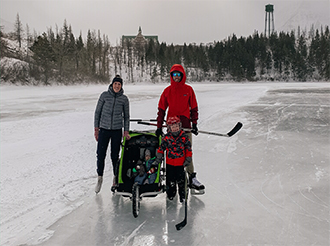
When Simon Schaerz offers parents tips for keeping their prepubescent children physically active, you might think his words flow from his experience as an instructor in the college’s Exercise Science program. Or maybe from his years working with student-athletes as the head coach of the Kodiaks’ cross country teams (the women are reigning national champs) which earned him Coach of the Year honours provincially in this sport.
Maybe his advice is born from his role as an active dad to two preschool-aged boys or from his own childhood spent hiking or biking the mountains of Switzerland, where he lived until he was 12.
But no, this advice is backed by research he’s completing as a PhD candidate at the University of Lethbridge Faculty of Education.
“I had an interest in looking at childhood physical activity from a developmental perspective,” he says. “It just so happened that when I was going through the research proposal stages, that’s when everything shut down (due to COVID). When the data was collected, there were no sports and kids could go out and play with their friends, but it was still relatively difficult to do.”
Simon enlisted a dozen families with children in his target age range of 10 to 13, from diverse socioeconomic backgrounds. He interviewed children and parents and the participants maintained a journal for a week in May of their activities. They each also carried a pedometer to count their steps.
The results were clear.
“Kids prefer to be active with others and they prefer play-based physical activity,” he says.
“As a parent, try to find ways to connect kids with their peers. Recess helps. Or take advantage of setting up play dates with children who are already in your child’s cohort at school.”
Stats show most children aren’t active enough to avoid the long-term pitfalls of physical inactivity. To accrue benefits, activity should occur daily. And, no, days of inactivity can’t be made up with long hours of occasional activity.

“Childhood physical activity in Canada and most western countries is very low,” he says. “In Canada, we’re talking about a 10 per cent range of kids meeting our own recommendations for 60 minutes of moderate to vigorous physical activity every day.”
With school back in session and activities like youth hockey and indoor soccer set to start in October, there are more opportunities to be active than when the shutdown began. For families facing financial struggles, there are organizations like Jumpstart that might help with the cost of organized sports.
In summer, bike rides were popular, but with winter coming, families may find ways to play in the snow that will appeal to children.
“Jump on any opportunity or invitation from your child to do something active,” he says.
The pandemic has sparked a wave of research into the implications of the shutdown on childhood development, work Simon has been watching with interest. He expects to finish writing his dissertation by next summer.
“We’re going to be reading about this for quite some time,” he says. “It’s exciting to be a part of that.”